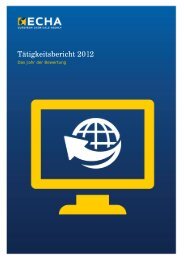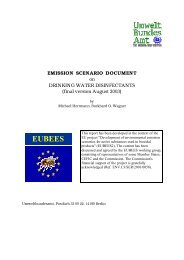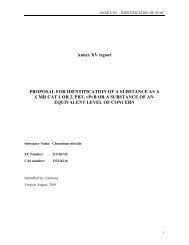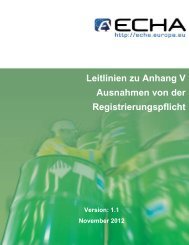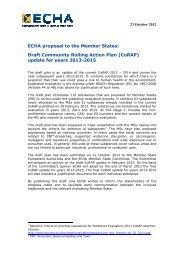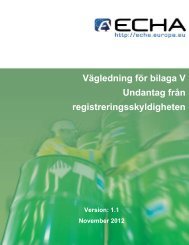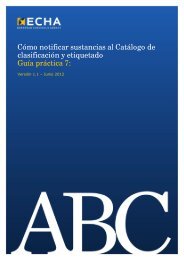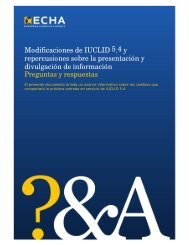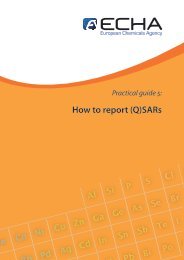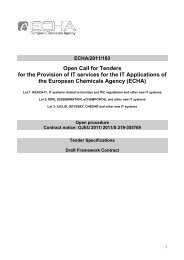Strategy For Limiting Risks Human Health Draft of ... - ECHA - Europa
Strategy For Limiting Risks Human Health Draft of ... - ECHA - Europa
Strategy For Limiting Risks Human Health Draft of ... - ECHA - Europa
Create successful ePaper yourself
Turn your PDF publications into a flip-book with our unique Google optimized e-Paper software.
This reaction is separate from the reduction reaction <strong>of</strong> alumina to aluminium in Hall-Héroult<br />
process, which is the only smelting process used today industrially. Based on the molar<br />
masses <strong>of</strong> Na2O and cryolite, approximately 2 times the mass <strong>of</strong> Na2O <strong>of</strong> excess cryolite<br />
results, if no other sources <strong>of</strong> sodium are available and if losses <strong>of</strong> cryolite are excluded. In<br />
this case, one tonne <strong>of</strong> alumina fed to the process would produce normally ca. 4-10 kg excess<br />
cryolite. According to EAA (2007a), two tonnes <strong>of</strong> alumina is reduced to one tonne <strong>of</strong><br />
aluminium. Hence, one tonne <strong>of</strong> primary aluminium is based on the assumptions above<br />
accompanied by ca. 8-20 kg (0.8-2 % w/w) <strong>of</strong> excess cryolite as by-product.<br />
In modern smelters excess bath material is tapped from time to time. Concentrations <strong>of</strong> bath<br />
components vary within and between the sites depending on the alumina quality, other<br />
substances are added to the bath and on other process parameters. An example <strong>of</strong> the contents<br />
<strong>of</strong> bath material has been provided by Alcoa (Solvay, 2007):<br />
Cryolite 51-53 %<br />
Al2O3 45 % (WS: insoluble or < 1 mg/l according to IUCLID<br />
AlF3 7 % (WS: 5.3-9.4 at pH 5.9, European Commission, 2008)<br />
CaF2 3 %<br />
MgF2 1.2 %<br />
Carbon 0.8 %<br />
Fe2O3 0.27 %<br />
SiO2 0.25 %<br />
Moisture 0.25 % (Rapporteur assumes H2O is meant by this)<br />
It is noted, that the Rapporteur considers that bath material has another identity than cryolite.<br />
Already based on the very low water solubility <strong>of</strong> the substantial constituent Al2O3, properties<br />
<strong>of</strong> cryolite do not resemble the properties <strong>of</strong> bath material.<br />
Production capacity and tonnage<br />
Intended production<br />
Cryolite is produced at four sites in the EU-15. All sites provided information on exposure.<br />
Sites 2, 3 and 4 updated their information in 2006. Production volume <strong>of</strong> these four sites is<br />
23,561 t/a <strong>of</strong> which 11,500 t/a is exported. The volume for the European market is thus<br />
12,061 t/a. Production capacity was provided by three companies and it makes 43,200 t/a.<br />
Table 1.1: Production sites <strong>of</strong> synthetic cryolite in the EU-15<br />
Company Location<br />
Derivados del Fluor S.A. Spain, Onton<br />
Fluorsid S.p.A. Italy, Assemini (Cagliari)<br />
I.C.I.B. S.p.A. Italy, Treviglio (BG)<br />
Solvay Fluor und Derivate Germany, Bad Wimpfen<br />
8



